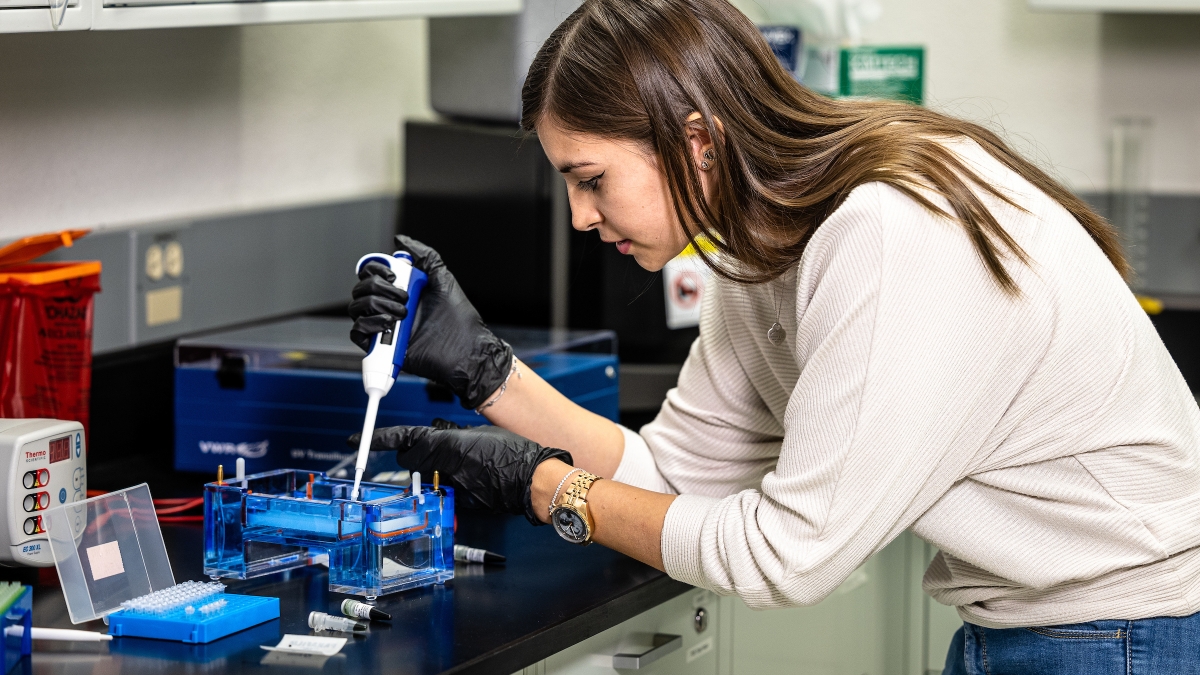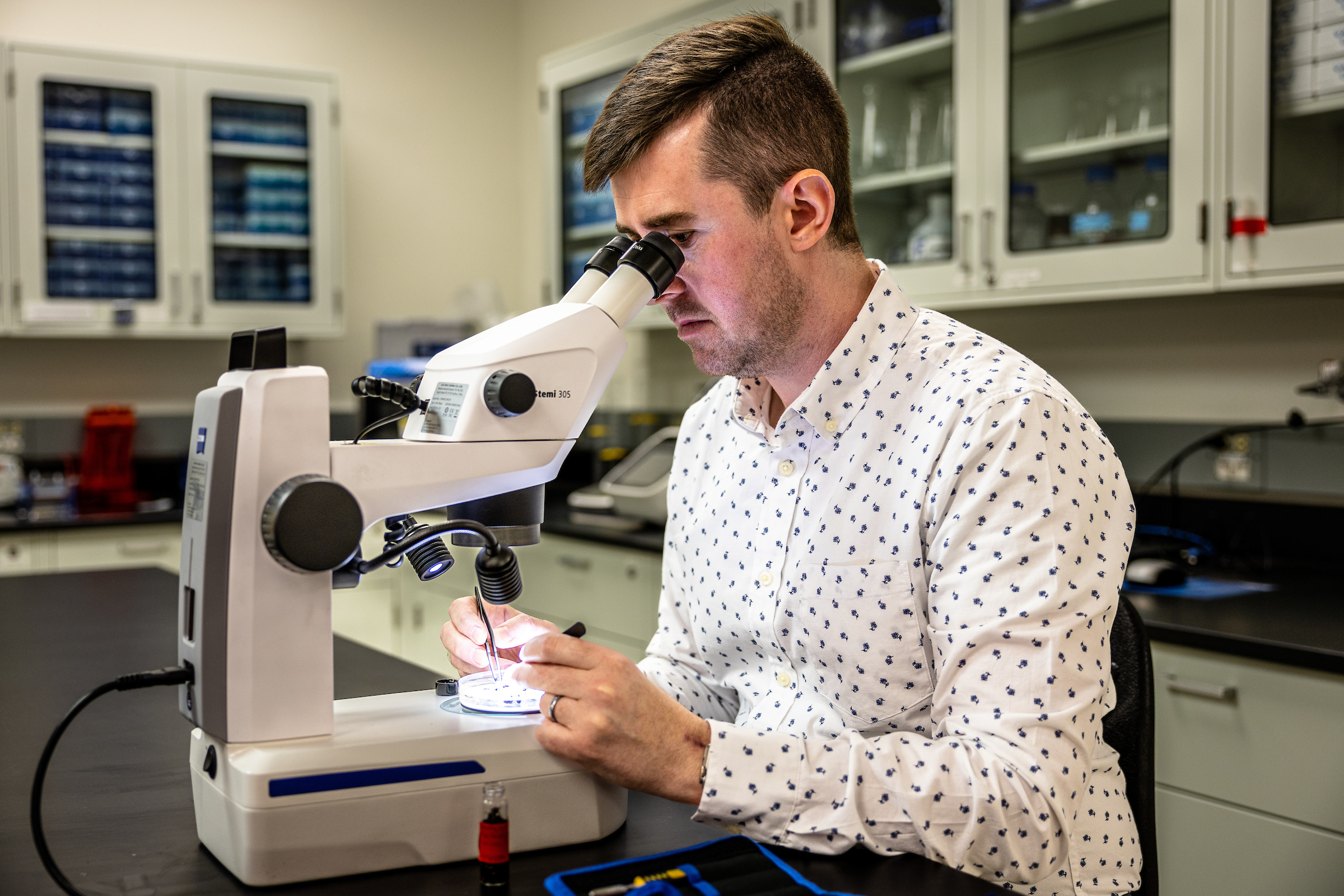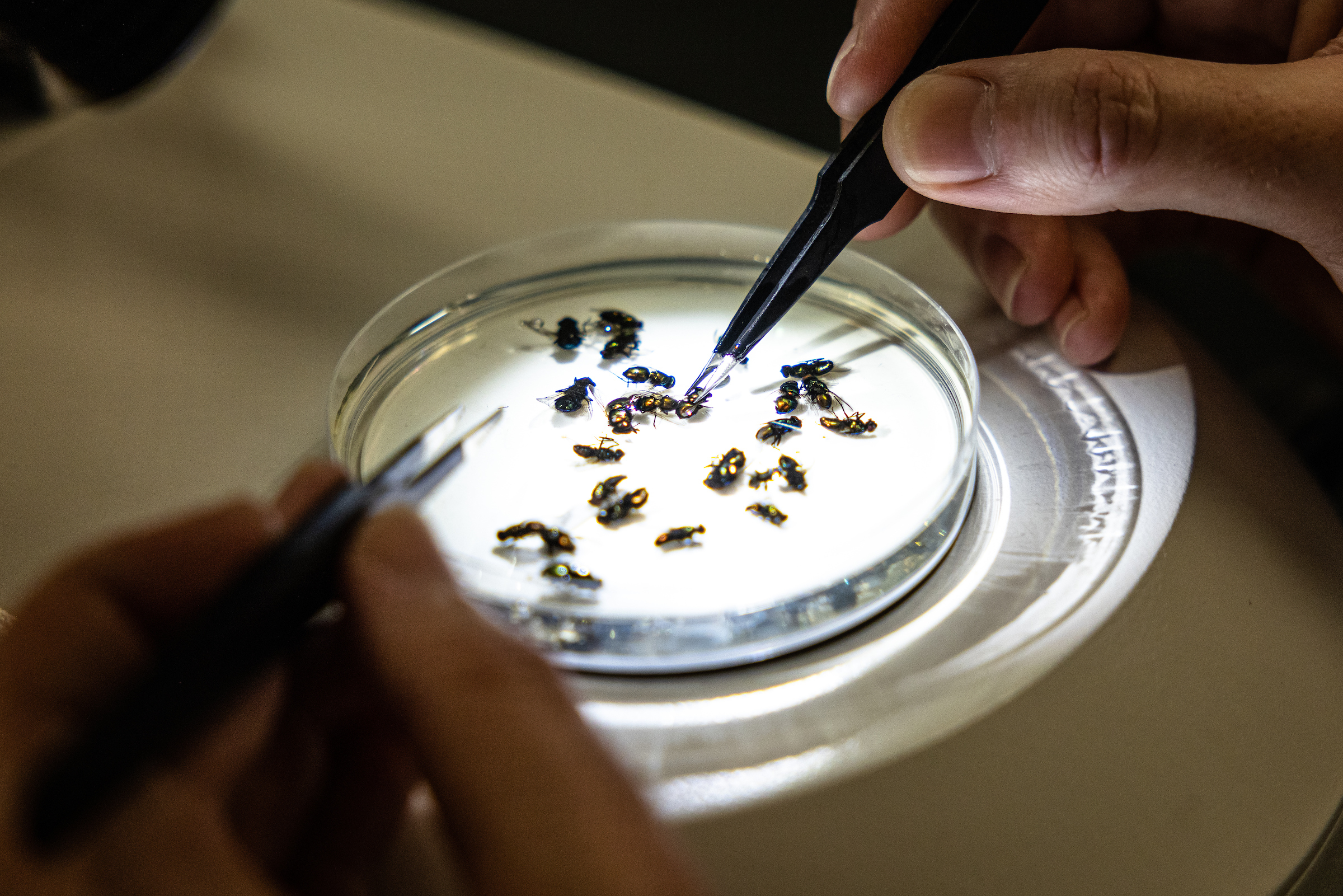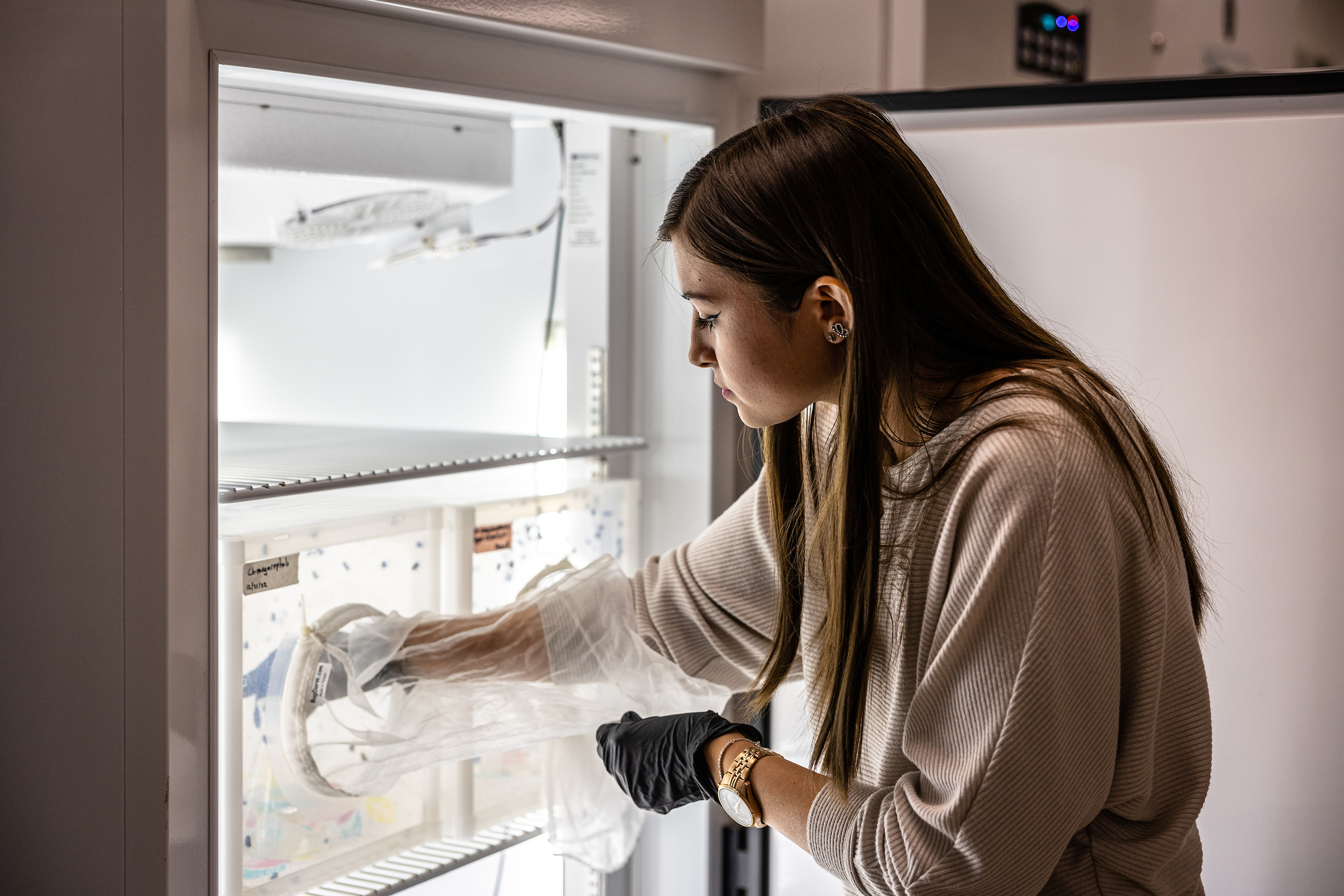Editor’s note: This story is featured in the 2023 year in review.
When detectives arrive on the scene of a murder, many questions arise.
When did the murder take place? What was the cause of death? Was the body moved?
The answers to these questions can come from an unexpected source — blowflies.
According to Jonathan Parrott, assistant professor of forensic science at Arizona State University, blowflies usually arrive on a crime scene just 10 minutes after a murder. They are drawn by body fluids and gasses associated with the decomposition of an open-air corpse, and like a fly on the wall, can reveal secrets about the homicide.
But in order to accurately answer these questions, investigators need to know the precise life cycle of the blowflies. That’s where Parrott’s research comes in.
For the past two years, the forensic entomologist has been developing one of Arizona’s first and much-needed genetic and developmental databases of forensically important blowflies to assist both crime scene investigators and the courts. The data will help determine more accurate and robust time-of-death estimations from insect evidence.
“Up until now, this data was missing from flies in Arizona,” says Parrott, who works in ASU’s New College of Interdisciplinary Arts and Sciences.
"What makes our research unique is that there has not been any DNA data alongside developmental work from Arizona blowflies available prior to our project,” says Parrott, who is also an executive committee member of ASU’s Future of Forensic Science Initiative — a transdisciplinary hub of scientists and practitioners pioneering a world-class intellectual space for forensic science.
“We are cataloging both morphological and genetic data."
Video by Ken Fagan/ASU News
Although it is a relatively new technology, Parrott says, “DNA is the gold standard in forensic science.”
“Having this type of data will strengthen forensic entomology in the criminal justice system."
Post-mortem messages
Using blowflies to solve murders is nothing new. According to the Chinese book "Collected Cases of Injustice Rectified," written in 1247, it dates back to 13th century China when a farmer was killed by a sickle. Villagers were asked for their sickles, and the murderer was discovered when swarms of flies descended upon the small traces of blood on one sickle.
Science has evolved since then, but one question remains — how does a blowfly crawl its way into a forensic murder investigation?
The secret is in the insect’s life cycle. The simplest explanation is that if, for example, a fly’s life span is 15–30 days from egg to fly and it takes five days to go from egg to maggot, a maggot-covered corpse would most likely have been dead for five days.
But it is more complicated than that — hence the need for a precise species and genetic database.
“Identification is the most critical step,” Parrott says. “Because if you identify the species wrong, you are going to be applying incorrect data to your estimated time of death.”
Assistant Professor Jonathan Parrott looks at blowflies in his forensic entomology research lab on ASU’s West campus. Photo by Charlie Leight/ASU News
And here’s where it gets tricky. A blowfly species found on a body abandoned off the road during the summer in Chandler, Arizona, for example, may have a different life cycle in the winter in Glendale, Arizona.
Believe it or not, blowflies are like people in some respects. They respond differently to various outside conditions.
“I’m from the United Kingdom," Parrott explained. "So I deal with heat very differently from someone born in Arizona, even though we are the same species. It’s the same with blowflies.”
Factors such as temperature, humidity and changing seasons can make calculations more complex and time consuming.
Project blowfly
Parrott and ASU undergraduates working in his lab are two-thirds of the way through the process of compiling the blowfly database of morphological and genomic data.
This is a huge project, Parrott says, with thousands of collected blowflies of forensic importance. In addition to determining species in the Phoenix area, his lab is expanding to surrounding states, in particular to areas where genetic data is missing and disturbances are limited — such as national parks and monuments.
“By analyzing species from different areas, especially at the genetic level, we can answer questions about species migration, possible invasive species and learn how climate change and human disturbances are affecting species migration,” he says.
Assistant Professor Jonathan Parrott looks at blowflies in his forensic entomology research lab. Photo by Charlie Leight/ASU News
Data development
Parrott and his team begin the process of accruing data with a simple plastic trap baited with a blowfly favorite: chicken liver. Traps are placed in an enclosed location just outside the lab where they can be undisturbed. Others are put in specific areas of Chandler and Avondale, Arizona. From 10 to hundreds of blowflies are collected each week and returned to the lab. At any given time there are about 3,000 blowflies in the lab.
There, insects are separated into different species — nine in all.
Some are placed in vials with an ethanol-water solution. These are studied under a microscope both morphologically and for DNA and RNA.
Others are placed in bug dorms — boxes covered with nets and put in an incubator, which controls temperature and humidity.
Still others are mounted and classified in display boxes.
“We are also using the DNA data to build standard operating procedures, which are absent in forensic entomology,” Parrott says. “Since some species of blowflies are very closely related, DNA sequences can separate one species from another.”
The data includes species, locations, dates, seasons, temperature, humidity and other conditions. Beginning this year, the electronic database will be released in increments for use by the general public.
Students rewarded with research experience
Parrott’s research lab is located on ASU’s West campus. His study is beneficial to both the forensic community and undergraduates that work in his lab.
“It has been rewarding to work on the database project. It’s expanded my knowledge in not only forensics but general entomology,” says Kathryn Melancon, an ASU sophomore majoring in forensic science.
“This project is important in the field of forensic entomology as it aids in identifying blowfly populations and their tendencies to stay in particular climates and locations,” says Melancon, who plans to work in forensic pathology. “This survey can also be used to monitor the rise and fall of populations.”
Lab manager and forensic psychology graduate student Sydnee Wedel checks on the blowflies in one of the incubators in Assistant Professor Jonathan Parrott’s forensic entomology research lab. The incubators enable researchers to control light, temperature and humidity for the insects. Photo by Charlie Leight/ASU News
Sydnee Wedel has worked in the lab for two years. By now, she is accustomed to the odor in the lab caused by the decomposition of liver and other meals that flies feast upon.
“I don’t even smell it anymore,” says Wedel, the manager of Parrott’s lab.
Wedel graduated from ASU in May 2022 with a degree in forensice science and a minor in criminology and criminal justice, and now manages the lab as a graduate student.
“I love solving problems and I love science, so it is perfect for me,” she says.
It is Wedel and the other undergraduates who collect the blowflies from different locations.
Wedel says that ASU has given her the opportunity to learn how to do research effectively and also carry out her own experiments.
Ultimately, she wants to work in a crime lab.
“I really want to help solve crimes,” Wedel says. “And my background here is giving me the edge I need to work in a crime lab.
“Being knowledgeable about maggots and pupae casings and everything else you might need to solve a crime can tell you so much. It can tell you where the body has been, where it was moved, how long it has been there or if it was covered or buried.”
Through her work, Wedel has come to appreciate blowflies that she once only considered an annoyance.
“There is so much you can learn about a murder,” she says, “just from the blowflies around the body.”
Top photo: Lab manager and forensic psychology graduate student Sydnee Wedel applies a blowfly's dyed DNA to an electrically charged gel bath in Assistant Professor Jonathan Parrott’s forensic entomology research lab on the ASU West campus. Photo by Charlie Leight/ASU News
More Science and technology

ASU professor wins NIH Director’s New Innovator Award for research linking gene function to brain structure
Life experiences alter us in many ways, including how we act and our mental and physical health. What we go through can even change how our genes work, how the instructions coded into our DNA are…

ASU postdoctoral researcher leads initiative to support graduate student mental health
Olivia Davis had firsthand experience with anxiety and OCD before she entered grad school. Then, during the pandemic and as a result of the growing pressures of the graduate school environment, she…

ASU graduate student researching interplay between family dynamics, ADHD
The symptoms of attention deficit hyperactivity disorder (ADHD) — which include daydreaming, making careless mistakes or taking risks, having a hard time resisting temptation, difficulty getting…



